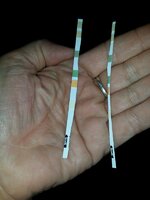PiddleMouse
Member
I think this will fit in well in this section, will move it if not?
Anyway, thought this worth sharing, although I can not take credit for this smart little idea, I saw it elsewhere.
Those testing strips as we all know are really expensive for what you get, but a guy online shared this way of getting double your money's worth.
My wobbly hands don't allow for neat cutting as you can see, but you will get the idea!
I always do this now, so hope it saves some of you a few bob also

Anyway, thought this worth sharing, although I can not take credit for this smart little idea, I saw it elsewhere.
Those testing strips as we all know are really expensive for what you get, but a guy online shared this way of getting double your money's worth.
My wobbly hands don't allow for neat cutting as you can see, but you will get the idea!
I always do this now, so hope it saves some of you a few bob also




